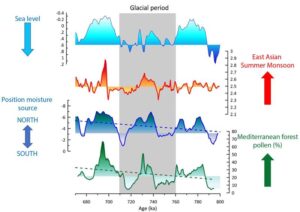

The “Joides Resolution” research vessel – here in the port of Lisbon – has been used since 1985 as part of the International Ocean Discovery Program for scientific drilling.
(c) André Bahr
Earth scientists identify pivotal step in the Earth’s later climate development.
Approximately 700,000 years ago, a “warm ice age” permanently changed the climate cycles on Earth. Contemporaneous with this exceptionally warm and moist period, the polar glaciers greatly expanded. A European research team including Earth scientists from Heidelberg University used recently acquired geological data in combination with computer simulations to identify this seemingly paradoxical connection. According to the researchers, this profound change in the Earth’s climate was responsible for the change in the climate cycles, thus representing a critical step in the later climate evolution of our planet.

Long-term expansion of Mediterranean forests and increase in precipitation as well as an enhanced East Asian summer monsoon associated with the increase and northward migration of the Atlantic moisture source.
(c) André Bahr
Geological ice ages – called glacial periods – are characterised by the development of large ice sheets in the Northern Hemisphere. In the past 700,000 years, phases shifted between distinct glacial and warm periods about every 100,000 years. Before then, however, the Earth’s climate was governed by 40,000-year cycles with shorter and weaker glacial periods. The change in the climate cycles occurred in the Middle Pleistocene Transition period, which began approximately 1.2 million years ago and ended about 670,000 years ago. “The mechanisms responsible for this critical change in the global climate rhythm remain largely unknown. They cannot be attributed to variations in the orbital parameters governing the Earth’s climate,” explains Associate Professor Dr André Bahr of the Institute of Earth Sciences at Heidelberg University. “But the recently identified ‘warm ice age’, which caused the accumulation of excess continental ice, did play a critical role.”
For their investigations, the researchers used new climate records from a drill core off Portugal and loess records from the Chinese Plateau. The data was then fed into computer simulations. The models show a long-term warming and wetting trend in both subtropical regions for the past 800,000 to 670,000 years. Contemporaneous with this last ice age in the Middle Pleistocene Transition period, the sea surface temperatures in the North Atlantic and tropical North Pacific were warmer than in the preceding interglacial, the phase between the two ice ages. This led to higher moisture production and rainfall in Southwest Europe, the expansion of Mediterranean forests, and an enhanced summer monsoon in East Asia. The moisture also reached the polar regions where it contributed to the expansion of the Northern Eurasian ice sheets. “They persisted for some time and heralded in the phase of sustained and far-reaching ice-age glaciation that lasted until the late Pleistocene. Such expansion of the continental glaciers was necessary to trigger the shift from the 40,000-year cycles to the 100,000-year cycles we experience today, which was critical for the Earth’s later climate evolution,” states André Bahr.
The results of this research were published in the journal “Nature Communications”. Scientists from Germany, France, Spain, and Portugal contributed to the research. The work was funded by the German Research Foundation.
Contact:
Communications and Marketing
Press Office
Phone +49 6221 54-2311
presse@rektorat.uni-heidelberg.de
Wissenschaftliche Ansprechpartner:
Associate Professor Dr André Bahr
Institute of Earth Sciences
Phone +49 6221 54-6062
andre.bahr@geow.uni-heidelberg.de
Originalpublikation:
M. F. Sánchez Goñi, T. Extier, J. M. Polanco-Martínez, C. Zorzi, T. Rodrigues, A. Bahr: Moist and warm conditions in Eurasia during the last glacial of the Middle Pleistocene Transition. Nature Communications (published online 10 Mai 2023); DOI: 10.1038/s41467-023-38337-4
Weitere Informationen:
https://www.geow.uni-heidelberg.de/researchgroups/friedrich/abahr_en.html












